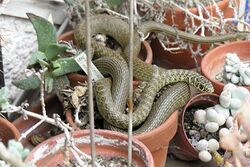Biology:Green whip snake
| Green whip snake | |
|---|---|

| |
| Scientific classification | |
| Domain: | Eukaryota |
| Kingdom: | Animalia |
| Phylum: | Chordata |
| Class: | Reptilia |
| Order: | Squamata |
| Suborder: | Serpentes |
| Family: | Colubridae |
| Genus: | Hierophis |
| Species: | H. viridiflavus
|
| Binomial name | |
| Hierophis viridiflavus (Lacépède, 1789)
| |
| Synonyms | |
|
Coluber gyarosensis Mertens, 1968 | |
The green whip snake or western whip snake (Hierophis viridiflavus) is a species of snake in the family Colubridae.
Geographic range and subspecies
This species is present in Andorra, Croatia, France , Greece, Italy, Malta, Slovenia, Spain , Switzerland , and possibly Luxembourg.[1]
Currently two subspecies are distinguished, a melanic (H. v. carbonarius) and a striped form (H. v. viridiflavus). The melanic form occurs in the eastern part of the range and the striped in the western part, with a contact zone throughout most of northern Italy.[2]
Habitat
Its natural habitats are temperate forests, temperate shrubland, Mediterranean-type shrubby vegetation, arable land, pastureland, plantations, rural gardens, and urban areas.[1]
Description
The green whip snake is a slender species with a small but well-defined head, prominent eyes with circular pupils, and smooth scales. The background colour is greenish-yellow but this is mostly obscured by heavy, somewhat irregular bands of dark green or black, particularly in the front half of the snake. The underparts are grey or yellowish and the tail has narrow longitudinal stripes. The young are a greyish colour and develop their full adult colouring by about their fourth year. This snake grows to a total length of about 150 cm (60 in).[3] In the northeastern part of its range, in Sicily and southern Italy, most individuals are blackish in colour. There is a larger, up to two metres (6.5 ft) long, often pure black variant – Coluber viridiflavus carbonarius (Bonaparte, 1833) – found in Italy and Malta.[4] referred to there as 'Il Biacco'.
Status
The green whip snake has a wide distribution and is very common within that range. The population is steady and faces no significant threats, apart from road kill and persecution, and the International Union for Conservation of Nature has assessed its conservation status as being of "least concern".[1]
Biology
These snakes mainly feed on lizards, skinks, frogs, mice, as well as on the young and eggs of small birds. This species lays four to 15 eggs.[1] They are very lively and when cornered, may bite furiously. They hibernate in winter.[4]
Venom and toxicity
Commonly regarded as non-venomous, it is described that a subject who endured 'sustained biting' of up to 5 minutes began showing suspect symptoms, including problems with neuromotor skills.[5] It has been recently discovered the presence of modified rear maxillary fangs in correspondence of a gland called the Duvernoy's gland, similar to the venom gland and involved in the production of toxins.
See also
- List of reptiles of Italy
References
- ↑ 1.0 1.1 1.2 1.3 1.4 Vogrin, MilanExpression error: Unrecognized word "etal". (2009). "Hierophis viridiflavus". IUCN Red List of Threatened Species 2009: e.T61449A86246670. doi:10.2305/IUCN.UK.2009.RLTS.T61449A12487580.en. https://www.iucnredlist.org/species/61449/86246670.{{cite iucn}}: error: |doi= / |page= mismatch (help)
- ↑ Storniolo, Federico; Mangiacotti, Marco; Zuffi, Marco A. L.; Scali, Stefano; Sacchi, Roberto (2023-06-01). "Large scale phenotypic characterisation of Hierophis viridiflavus (Squamata: Serpentes): climatic and environmental drivers suggest the role of evolutionary processes in a polymorphic species" (in en). Evolutionary Ecology 37 (3): 419–434. doi:10.1007/s10682-023-10234-8. ISSN 1573-8477. https://doi.org/10.1007/s10682-023-10234-8.
- ↑ Arnold, E. Nicholas; Ovenden, Denys W. (2002). Field Guide: Reptiles & Amphibians of Britain & Europe. Collins & Co.. p. 207. ISBN 0-00-219964-5.
- ↑ 4.0 4.1 "SNAKES OF THE MALTESE ISLANDS". http://www.shadowservices.com/nature/Maltese/biology/snakes.htm.
- ↑ Nuwer, Rachel (October 18, 2013). "Some seemingly harmless snakes possess a secret venomous gland". Smithsonisn Magazine. http://www.smithsonianmag.com/smart-news/some-seemingly-harmless-snakes-possess-a-secret-venom-gland-2668124/?no-ist.
Wikidata ☰ Q844254 entry
 |




